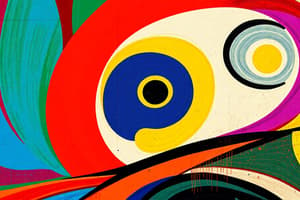Podcast
Questions and Answers
What was the main impact of cel animation on efficiency and quality?
What was the main impact of cel animation on efficiency and quality?
Cel animation streamlined the animation process by allowing for the reuse of backgrounds, thus improving efficiency and maintaining high quality in character movements.
How did the slash system enhance the animation process?
How did the slash system enhance the animation process?
The slash system minimized the need to redraw backgrounds by allowing animators to focus on character movements and actions, thus increasing productivity.
What was the significance of Max Fleischer's invention of the rotoscope in 1915?
What was the significance of Max Fleischer's invention of the rotoscope in 1915?
The rotoscope enabled animators to trace over live-action footage, creating more realistic animations and bridging the gap between real movements and animated forms.
What contributions did Lotte Reiniger make to European animation?
What contributions did Lotte Reiniger make to European animation?
How did the use of puppets in early animation influence storytelling techniques?
How did the use of puppets in early animation influence storytelling techniques?
What advancements characterized the animation industry during the 1920s?
What advancements characterized the animation industry during the 1920s?
What role did Mickey Mouse play in the rise of Disney during the 1930s?
What role did Mickey Mouse play in the rise of Disney during the 1930s?
What was the cultural impact of the character Betty Boop created by Max Fleischer?
What was the cultural impact of the character Betty Boop created by Max Fleischer?
What is animation and why is it significant in visual storytelling?
What is animation and why is it significant in visual storytelling?
Describe the function of the thaumatrope in the history of animation.
Describe the function of the thaumatrope in the history of animation.
How did Eadweard Muybridge contribute to the study of motion?
How did Eadweard Muybridge contribute to the study of motion?
What is 'Fantasmagorie' and why is it significant in animation history?
What is 'Fantasmagorie' and why is it significant in animation history?
What role did Winsor McCay play in the evolution of animation?
What role did Winsor McCay play in the evolution of animation?
Explain the significance of the peg system in animation production.
Explain the significance of the peg system in animation production.
What contributions did George Méliès make to early cinema and animation?
What contributions did George Méliès make to early cinema and animation?
What early animation studios emerged during the pre-1927 era and why were they important?
What early animation studios emerged during the pre-1927 era and why were they important?
Flashcards are hidden until you start studying
Study Notes
Unit 1: The Origins of Animation
- Animation is the technique of creating the illusion of movement through a series of individual frames, significantly enriching visual storytelling.
- Before 1900, devices like the thaumatrope and phenakistoscope laid early foundations for animation, allowing static images to appear in motion.
- The zoetrope and praxinoscope emerged as advancements, enhancing the complexity of animations and encouraging artistic creativity.
- The magic lantern served as one of the earliest projectors, crucial for displaying images and animated sequences.
- Eadweard Muybridge is pivotal for motion photography, with his notable work, "The Horse in Motion," leading to the analysis of motion.
- Muybridge’s techniques greatly influenced future studies in motion, acting as a precursor to motion picture development.
- The advent of celluloid film and motion picture cameras was key, with contributions from inventors like Thomas Edison and the Lumière brothers.
Unit 2: 1900-1927 Film Animation
- Early 20th-century animations were characterized by experimental techniques that pushed the boundaries of film.
- George Méliès was instrumental in early cinema, known for innovative special effects and storytelling through animation.
- James Stuart Blackton created "Humorous Phases of Funny Faces," showcasing one of the first animated films with drawn characters.
- Emile Cohl's "Fantasmagorie" is recognized as the first fully animated film, marking a significant milestone in animation history.
- Winsor McCay's "Gertie the Dinosaur" represented a leap in character animation, demonstrating character personality and interaction.
- The establishment of animation studios, like Fleischer Studios and Bray Productions, reflected the growing industry and professionalism in animation.
- The peg system was developed to improve positioning of animation frames, enhancing workflow in production.
- The introduction of cel animation improved efficiency and quality by allowing for static backgrounds while characters were animated separately.
- The slash system streamlined production by reducing the need to redraw backgrounds for different scenes, promoting efficiency.
- Max Fleischer invented the rotoscope in 1915, providing a method to trace over live-action footage for realistic movements in animation.
- European animation witnessed significant innovations, notably through Lotte Reiniger’s silhouette animations that added depth to storytelling.
- Puppetry played a role in early animation, introducing complexities in narrative and character portrayal through movement.
- The 1920s experienced key advancements in animation, including the rise of iconic characters and studio techniques.
- The emergence of Felix the Cat as one of the first animated characters had a lasting cultural impact and popularity.
- Walt Disney's early venture with Newman's Laugh-O-Grams began his journey in animation, influencing character development and storytelling.
- Lotte Reiniger's silhouette animation techniques, especially in "The Adventures of Prince Achmed," were groundbreaking in the art of animation.
Unit 3: 1928-1957 The Golden Age
- The integration of sound in animation began with Disney's "Steamboat Willie" (1928), introducing synchronized audio and visuals through Mickey Mouse.
- Mickey Mouse’s rise during the 1930s revolutionized the animation industry, leading to an increased focus on character-driven storytelling.
- Animation techniques evolved throughout the 1930s, advancing towards realistic animation styles and character designs.
- Betty Boop, created by Max Fleischer, became a cultural icon, reflecting the changing social landscape through animation.
Studying That Suits You
Use AI to generate personalized quizzes and flashcards to suit your learning preferences.




